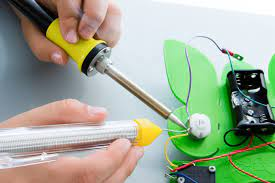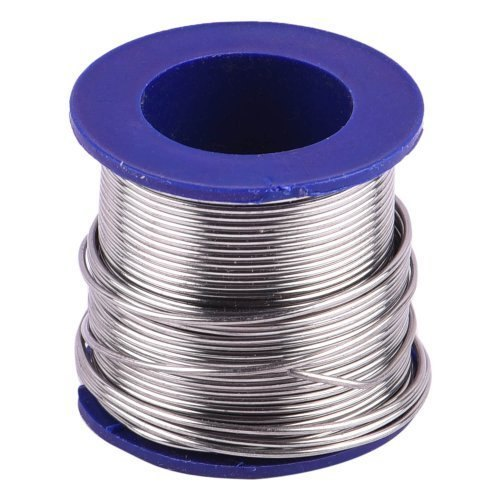Soldering process Goes Easy

Solder lead and soldering is the process of joining two metals together with a soldering iron and using solder and solder to form an electrical connection. It commonly employs a low melting point metal alloy (solder) that is melted and applied to the metal parts to be bonded.
It is glue that binds different metals strongly. Soldering is done below 800 degrees Fahrenheit. This article will provide basic welding instructions for beginners to learn manual soldering with solder lead.
Safety Precautions before Starting Welding
Most solder lead contains lead. In the process of soldering, lead can produce dangerous smoke for health. Some important precautions are given below.
Firstly, use a fume hood
Secondly, the soldering lead is very hot. Never touch the tip of the torch with your hands.
Also, never put the torch down on anything other than the iron holder.
Moreover, wear eye protection while welding solder lead.
Do not cut the ground pin on the torch plug to make it fit into an ungrounded outlet.
When heating solder wire, solder tin, must be held with tweezers to avoid burning
Aso, wear an ESD protective ring if you want to solder electrostatic-sensitive components
Finally, wash hands with soap and water after welding.
Choose the appropriate soldering iron
The main requirement in the welding process heat is protection. The soldering lead is the heat-generating tool. There are many different options such as soldering stations, soldering irons, and soldering guns. These types come in a wide variety of shapes, sizes, and capacities.
Sufficient heat is required to quickly melt the solder lead. It can burn or melt the delicate electronic components on the board if we heat too much. Not paying attention to the temperature of the solder lead can accidentally damage things if there is too much heat.
Temperature controlled of solder lead
Too much heat from the solder lead can damage or even break the copper conductors and pads on the board. When using a temperature-controlled torch (or soldering station) it is possible to know if the tip is hot enough for the material being soldered.
It makes the welding process a lot easier. The temperature of the torch can be adjusted by the temperature control knob. From there, you can be assured that the soldering iron is hot enough and ready to solder, and not so hot that it burns the components on the board.
The commonly used solder lead alloy
To be able to solder, it is necessary to have a soldering iron, solder lead, or more precisely, solder alloy.
One of the most commonly used solder alloys is 60% tin (Sn) and 40% lead (Pb).
Another commonly used solder alloy is 63% tin (Sn) and 37% lead (Pb) -
These are especially good for small electronic parts.
Solder lead prepares to weld
Turn on the power switch on the soldering station. Select the appropriate temperature by turning the knob on the front. Most good soldering stations take 1-2 minutes to reach the desired temperature. Use distilled water to moisten the sponge in the holder.
The torch tip should be cleaned before each use by wiping it on a wet sponge (when the torch tip is hot enough). Newly purchased soldering iron needs to be heated and then coated with solder and solder lead before first use.
Cleaning in solder lead
Clean the spot to be soldered and all components. All components must be clean and free from oxidation or any other problems. Good soldering cannot be done on a dirty solder surface because the solder lead and solder will not stick to dirty components or dirty pads on the board.
The copper pads on the board should be cleaned with a solvent to remove grease. And a sharpening rod can be used if necessary. Then I need to use solder flux.

Flux is a mixture of natural and synthetic resins. It helps to remove the oxide film before and during welding.
Process of Solder and solder lead
Insert the component onto the board using tweezers.
If the solder lead is hot enough, it can be removed from the holder.
Place the tip of the torch on the weld and hold for a few seconds.
Make sure that the tip of the solder lead touches the copper pad and the component pin.
Touching only one of the two will form a very poor weld.
Thermal bonding in solder lead
Thermal bonding is the contact area between the torch tip and the surface of the weld. The contact between the torch tip and the surface is a very small straight line. Thermal bonding can be greatly improved by adding a small amount of solder to the contact line.
Solder lead, molten solder forms a thermal bridge between the tip of the soldering iron and the solder joint. This bridge transfers heat better and faster into the weld. Continue heating and then add a little solder to the solder joint. Solder lead will heat and melt on the copper surface.
Check the Solder lead process
The welding operation should be completed in less than 2 seconds. The welding operation time depends on the temperature of the torch and the size of the weld. Continued heating for longer than 2 seconds may break the pads on the board or damage temperature-sensitive components.
Take out the soldering iron while keeping the solder lead in place. Do not move the board for a few seconds to allow the solder to cool and the solder to solidify. Immediately after welding is complete, begin visual inspection of the weld.
Lead enters the human body by many ways such as:
- Water
- air or
Therefore, long-term exposure to solder containing lead components is also hazardous to health. This is also the reason that lead-based solder is not good in plumbing joints anymore. It is good for electric welding, because it can be toxic. For the welders themselves it is risky.
At present, solder-lead alloys have good standing against copper or antimony. And from there also came the concept of lead-free solder, which does not contain lead in its compounds.




